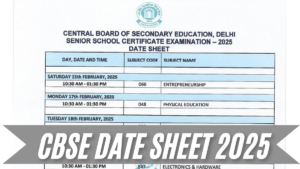The newly updated UP Board Class 12 Biology Syllabus 2025-26 has recently been released by the Uttar Pradesh Madhyamik Shiksha Parishad. All the class 12th science stream students with Biology as one of their major subjects can now check the detailed unit-wise UP Board Class 12 Biology Syllabus for the academic year 2025-26 either at the official website of the UPMSP, i.e., www.upmsp.edu.in, or by simply clicking on the direct link shared below. They can also access their complete official syllabus PDF from the article below. Students can also check the complete chapter-wise important topics along with the newly released UPMSP Class 12 Exam pattern 2025-26, which has been explained in the article.
UP Board Class 12 Biology Syllabus 2025-26
Students benefit greatly from the UP Board Class 12 Biology syllabus since it provides a solid foundation for both board exams and competitive tests like NEET and CUET. It covers every fundamental aspect of biology, such as ecology, reproduction, evolution, genetics, and human welfare. Students can learn a great deal about living things, life processes, and contemporary scientific ideas by studying this syllabus. It enhances analytical and scientific thinking abilities in addition to helping students do well on tests. Students can plan their preparation more effectively and systematically by consulting the comprehensive unit-by-unit syllabus provided below.
UP Board Class 12th Biology Unit-Wise Syllabus
- Unit 1: Reproduction
- Unit 2: Genetics and Evolution
- Unit 3: Biology in Human Welfare
- Unit 4: Biotechnology and Its Applications
- Unit 5: Ecology and Environment
UPMSP Class 12 Biology Detailed Syllabus 2025-26
The detailed UP Class 12 syllabus for Biology consists of 5 major units with many different chapters, covering all the essential topics students need to study. By following the syllabus carefully, students can plan their studies properly. Along with the syllabus, students should also use previous year papers, sample papers, and important notes to boost their preparation and improve their marks. Students can check the chapter-wise syllabus below and start preparing smartly for better results in the upcoming board exams.
Unit 1: Reproduction
- Sexual Reproduction in Flowering Plants
Structure of flower, development of male and female gametophytes, pollination, types, outbreeding devices, pollen-pistil interaction, double fertilization, post-fertilization events, development of endosperm and embryo, seed and fruit formation, special modes-apomixis, parthenocarpy, polyembryony, significance of seed and fruit formation.
- Human Reproduction
Male and female reproductive systems, microscopic anatomy of testis and ovary, gametogenesis – spermatogenesis and oogenesis, menstrual cycle, fertilization, implantation, embryonic development up to blastocyst formation, pregnancy, placenta formation, parturition, and lactation.
- Reproductive Health
Reproductive health, problems, and strategies, need for reproductive health and prevention of sexually transmitted diseases, birth control, contraception, and medical termination of pregnancy (MTP), amniocentesis, infertility, and assisted reproductive technologies (ARTs).
Unit 2: Genetics and Evolution
- Principles of Inheritance and Variation
Mendelian inheritance, deviations from Mendelism (incomplete dominance, co-dominance, multiple alleles, and inheritance of blood groups), pleiotropy, elementary idea of polygenic inheritance, chromosome theory of inheritance, chromosomes and genes, sex determination, linkage and recombination, sex-linked inheritance, Mendelian disorders in humans (color blindness, hemophilia, sickle cell anemia, phenylketonuria), chromosomal disorders in humans (Down syndrome, Turner syndrome, Klinefelter syndrome).
- Molecular Basis of Inheritance
Structure of DNA and RNA, DNA packaging, DNA replication, transcription, genetic code, translation, gene expression and regulation (lac operon), genome and human genome project, DNA fingerprinting.
- Evolution
Origin of life, biological evolution, evidence for evolution (paleontological, comparative anatomy, embryology, molecular evidence), Darwin’s contribution, modern synthetic theory of evolution, mechanism of evolution (variation, mutation, recombination, natural selection, genetic drift, gene flow), Hardy-Weinberg principle, adaptive radiation, human evolution.
Unit 3: Biology in Human Welfare
- Human Health and Diseases
Pathogens, parasites causing human diseases (malaria, dengue, chikungunya, filariasis, ascariasis, typhoid, pneumonia, common cold, amoebiasis, ringworm), basic concepts of immunology – vaccines; cancer, HIV and AIDS, adolescence, drug and alcohol abuse.
- Microbes in Human Welfare
Microbes in household products, industrial production, sewage treatment, energy generation, as biocontrol agents and bio-fertilizers, antibiotics, production, and judicious use.
Unit 4: Biotechnology and Its Applications
- Biotechnology: Principles and Processes
Genetic engineering (recombinant DNA technology), cloning vectors, processes of recombinant DNA technology, and applications of biotechnology in health and agriculture.
- Biotechnology and its Application
Applications in health and agriculture: human insulin and vaccine production, gene therapy, genetically modified organisms – Bt crops, transgenic animals, biosafety issues, biopiracy, patents.
Unit 5: Ecology and Environment
- Organisms and Populations
Organism and its environment, population and ecological adaptations, population interactions, population attributes, growth, birth rate, death rate, age distribution.
- Ecosystem
Ecosystem, structure and function, productivity and decomposition, energy flow, pyramids of energy, ecological succession, nutrient cycling (carbon and phosphorus), ecosystem services, ecological pyramids.
- Biodiversity and Its Conservation
Biodiversity, its importance, types, patterns, loss, biodiversity conservation (in-situ and ex-situ conservation), biosphere reserves, national parks, sanctuaries, hot spots, endangered organisms, extinction.
UP Class 12 Biology Syllabus 2025-26 PDF Download Link
The official link to check and download the newly updated UP Board class 12th Biology Syllabus has been activated at the official website of the Uttar Pradesh Madhyamik Shiksha Parishad (UPMSP). The syllabus not only helps to know which chapters will be included in the exams, but also consists of the complete exam pattern, chapter-wise weightage, marks distribution, and many more things that students are required to perform well in their final Class 12th board exams. Students can also check their UPMSP Class 12 Biology Syllabus PDF by simply clicking on the direct link shared in the article below.
Chapter-Wise Important Topics for UP Board Class 12 Biology Exam
UP Board Class 12 Biology preparation becomes much easier when students know the chapter-wise important topics. These topics are important because they highlight the areas from which most exam questions are asked. By focusing on them, students can save time, revise smartly, and avoid missing out on high-scoring concepts. Having a clear idea of important topics also reduces stress and boosts confidence during exams. Students can check the detailed chapter-wise important topics for Biology in the table given below.
| Chapter-Wise Important Topics for UP Board Class 12 Biology Exam | ||
| Chapter No. | Chapter Name | Important Topics |
| Chapters 1 | Reproduction in Organisms | Asexual and sexual reproduction, vegetative propagation. |
| Chapter 2 | Sexual Reproduction in Flowering Plants | Development of male and female gametophytes, pollination, double fertilization, seed and fruit formation. |
| Chapter 3 | Human Reproduction | Male and female reproductive systems, gametogenesis, menstrual cycle, fertilization, pregnancy, and lactation. |
| Chapter 4 | Reproductive Health | Contraception, sexually transmitted diseases, infertility, and assisted reproductive technologies. |
| Chapter 5 | Principles of Inheritance and Variation | Mendelian inheritance, deviations (incomplete dominance, co-dominance), chromosomal theory, sex determination, and genetic disorders. |
| Chapter 6 | Molecular Basis of Inheritance | Structure of DNA and RNA, replication, transcription, translation, gene regulation, human genome project, DNA fingerprinting. |
| Chapter 7 | Evolution | Origin of life, evidence of evolution, Darwin’s theory, modern synthetic theory, mechanisms of evolution, human evolution. |
| Chapter 8 | Human Health and Diseases | Pathogens and parasites, human diseases (malaria, dengue, etc.), immunology, vaccines, cancer, HIV and AIDS. |
| Chapter 8 | Microbes in Human Welfare | Microbes are used in food production, industrial production, sewage treatment, biofertilizers, and antibiotics. |
| Chapter 9 | Biotechnology: Principles and Processes | Genetic engineering, cloning vectors, and processes of recombinant DNA technology. |
| Chapter 10 | Biotechnology and Its Application | Applications in health (gene therapy, insulin production) and agriculture (Bt crops, transgenic animals). |
| Chapter 11 | Organisms and Populations | Population interactions, ecological adaptations, and growth patterns. |
| Chapter 12 | Ecosystem | Structure and function, energy flow, ecological pyramids, nutrient cycling. |
| Chapter 13 | Biodiversity and Its Conservation | Types and patterns of biodiversity, conservation methods, biodiversity hotspots, and extinction. |
UP Board Class 12 Biology Exam Pattern 2026
As the the newly released exam pattern, the UP Board class 12th biology exam will be held for a total of 100 marks, out of which the theory exam is for 70 mark,s while the rest 30 marks are for the practical exams. Students should start to improve their time management skills as the exam will be conducted for a total duration of 3 hours. The Question paper will be divided into four different sections: Section A, Section B, Section C, and Section D.
- Section A consists of 4 Multiple Choice Questions (MCQs), one mark each, which makes a total of 4 Marks.
- Section B is a set of 5 different, very short/one-word question answers. These questions are also of 1 mark each.
- Section C includes 08 Short Answer Type Questions. Each question in this section is of 2 marks, which makes a total of 16 Marks.
- Section D will consist of 2 Long Answer Type Questions, each of 5 Marks.










 UPMSP Center List 2026 Released, Check D...
UPMSP Center List 2026 Released, Check D...
 UP Board Class 12 Syllabus 2025-26 Out, ...
UP Board Class 12 Syllabus 2025-26 Out, ...
 CBSE Date Sheet 2025 Out, Download Class...
CBSE Date Sheet 2025 Out, Download Class...







